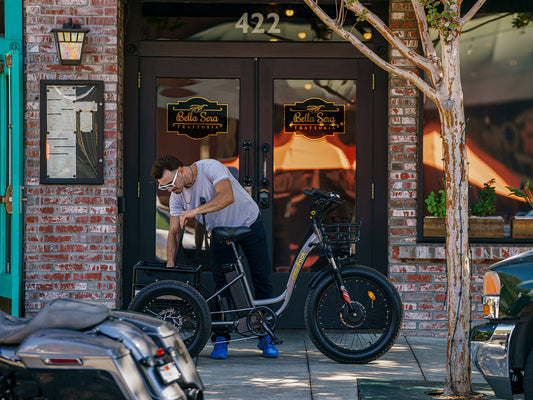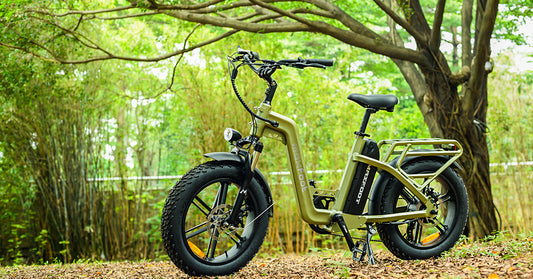Electric bikes have certainly made their mark on the commuting landscape, but there’s a new player turning heads on the road: the electric trike. As they gain traction, it’s natural to wonder about their performance. Questions are buzzing: Can these electric tricycles keep pace with their two-wheeled counterparts? Are they fast or slower? And really, what’s the speed difference between the two?
We have noticed the curiosity building up, and it’s high time we addressed it. This article is set to tackle those burning questions about electric trike speed, power, and efficiency. Our goal is to navigate you through the speed dynamics of etrikes and to assess how well they meet the demands of your daily commute.
What Factors Influence the Speed of Electric Bike
We’ll start with technicalities, i.e. the factors that, in general, influence the speed. The specified speed and the actual one are dependent on these few factors.
Motor Power
Picture the motor of an electric trike similar to an engine in a car. The stronger the motor, the more torque it has to spin the wheels, propelling you forward faster.
However, here motor doesn’t have much flexibility when compared to engine vehicles; the motor power is capped to certain limits due to laws and regulations.
Weight (Cargo)
The speed that manufacturers advertise, like 20mph, is based on a standard load — the trike itself plus an average rider. Toss in a few bags or some extra weight, and the motor has to work harder, fighting against the added friction. It is a simple equation: more weight equals more effort to maintain speed. This leads to a potential decrease in how fast you can go.
Wheel Size
Tires, their width and size also influence speed greatly. Larger wheels can cover more distance with each rotation, leading to higher speeds. Narrower tires reduce rolling resistance and can help the etrike move faster. Whereas, wider tires may offer more stability but can slow it down.
Terrain Type
Just like cars, electric tricyles move differently depending on the surface. Smooth, paved roads allow for quicker travel, while rough or uneven terrain can reduce speed as the trike works harder to navigate the obstacles.
Battery
The battery does power the motor so it’s another indirect factor that can affect speed consistency. If the battery is near depletion, it will become harder to maintain a particular speed, and at times to save battery you’ll have to travel at lower speeds.
What is the Top Speed of an electric tricycle?
Electric trikes are categorized in the same class system as ebikes. And most of the market standard bikes fall as Class 2 ebikes, and have 500W or 750W motors. And with this setup, the etrike's speeds are generally limited to 20 mph with pedal assist or throttle.
And for those who like to push the envelope with manual effort, pedaling beyond the assisted 20 mph is also possible.
Electric Trikes Speed Comparison with Ebikes
When we line up electric trikes alongside their Class 2 e-bike counterparts, we find that both are initially on an even keel, speed-wise, with a standard cap of 20mph. However, multiple ebike models exist which easily move past 23 mph or 28 mph. So, in general, they’re a bit behind bikes but we need to be aware of why is it so.
Ebikes are generally built for speed and agility; they feature two thin wheels, lighter frames, and sometimes more powerful motors within the higher classes. On the other hand, electric trikes prioritize stability and cargo capacity, which naturally leads to a sturdier and often heavier build.
This difference in design and purpose means that an e-bike might sprint ahead on open roads, but an electric tricyle will offer a more balanced ride, especially when carrying goods or navigating busy city streets.
Speed Regulations for Electric Tricycles: Are They Legal
In the United States, electric trikes fall under the same regulatory umbrella as e-bikes. By definition, these are vehicles equipped with a seat, fully functional pedals, and an electric motor that does not exceed 750 watts (approximately 1 horsepower). The law recognizes three classes of electric bicycles: Class 1, Class 2, and Class 3.
Class 1 and Class 2 electric bikes, which include electric tricycles, have their motor-assisted speeds capped at 20 mph. For these classes, there’s no need for a license or registration to operate them on public roads. This makes Class 2 electric trikes street legal in nearly all states across the US, with the 20 mph speed serving as the standard maximum for safety and regulatory compliance.
How Much Can be Achieved with This Speed?
The 20 mph speed cap on electric trikes might seem modest, but it unlocks multiple practical uses that can transform your day-to-day activities.
- Deliveries:ETrikes can navigate through traffic with ease, offer ample space for parcels, and the 20 mph speed is faster than a car stuck in city congestion. Plus, they can access routes that vehicles can't.
- Leisure Rides:They provide a stable ride, which is great for scenic routes in parks or beachfronts. The speed is safe for shared paths, yet fast enough to cover significant ground for sightseeing and exploration.
- Commuting:Electric trikes are an excellent option for commuters. You get a sweat-free ride to the office without compromising on speed, and there is no need to battle for parking spaces.
- Family Outings:Trikes are family-friendly, too. They can be equipped with child seats or cargo bins, making them suitable for school runs or family picnic.
A Spotlight on Maxfoot MF-30: A Quick Electric Tricycle for Adults

For those in need of a versatile, quick, and long-range three-wheeler, we present Maxfoot MF-30. It has got a powerful 750W motor, which takes it to the standard 20 mph.
It has recently got an upgrade with a UL2271 Certified Battery, which has added 23% more range to it. You now get 85+ miles of pedal assistance with PAS I.
With a payload capacity of up to 350 lbs. , the MF-30 is ready to handle significant loads, making it ideal for everything from grocery runs to equipment transport. The step-through frame design ensures easy mounting and dismounting, a feature that will be appreciated by riders of all ages and abilities.
Final Words
The commuting landscape is evolving, and electric trikes are leading the charge. They’re fast, and stable, and open up new opportunities for those seeking the freedom of a personal ride. The Maxfoot MF-30 exemplifies the best of what an electric trike can offer.
Eager for an adventure? Get your Maxfoot MF-30 today and experience the joy of three-wheeled travel.




